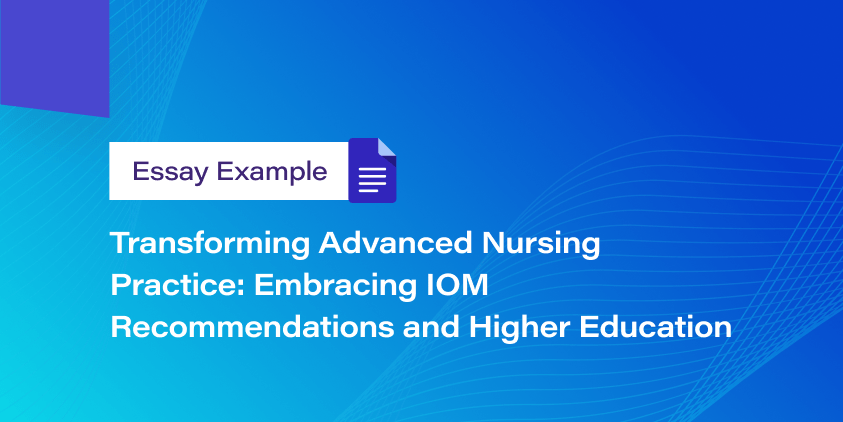Transforming Advanced Nursing Practice: Embracing IOM Recommendations and Higher Education

Although advanced nursing practice is critical to providing quality services, this occupation is associated with numerous challenges. Consequently, the Institute of Medicine (IOM) developed recommendations to improve advanced nursing practice by advancing nursing education. Nevertheless, the transformation of advanced nursing requires changes in training, licensing, and certification systems.
Implementing IOM Recommendations
In 2011, the IOM published a report with recommendations for future nursing aimed at improving the quality of the healthcare system. According to it, expanding the use of Advanced Practice Registered Nurses (APRNs) as primary and transitional care providers is one of the most effective ways to improve healthcare services. Nevertheless, there is a need to address limitations that affect the advanced nursing practice today. In addition, introducing restrictions on reimbursement for Medicaid is suggested, as it would encourage more patients to seek APRN services, increasing medical access to the underserved population. The IOM suggests that nurses attain higher educational levels and receive additional training. At the same time, there should be resident programs for APRNs interested in advancing their skills and training. Moreover, there is a need to reevaluate the current nursing program to include the additional competencies and to introduce changes that have occurred over the years in care provision.
The third recommendation of the IOM is the training of leaders, who would act as partners for physicians and other healthcare providers and be accounted for their contributions. Therefore, nursing training should include intense leadership skill development and collaborative work. Notably, the healthcare sector should make significant expenditures for infrastructure and resources to improve data collection and communication.
Importance of Doctor of Nursing Practice Education
The profound changes in the healthcare system and the rising need for a higher quality of care services necessitate continuous education, even after receiving a license from the healthcare provider. A survey conducted in 2012 indicated that 94% of nurses held nursing degrees, while 86% of these registered nurses had a master’s one. Only 5% of registered nurses had doctoral degrees. Completing a doctorate program is vital to my practice. It will help me offer better healthcare services in complex situations and give me a competitive advantage over other APRNs. In addition, it will facilitate translating evidence-based care to practice, improving the care system and enhancing care outcomes in patients and communities. This program improves understanding of the nature of healthcare and its delivery and helps evaluate the effectiveness of any intervention, which is important for professional family nurse practitioners.
The Doctor of Nursing Practice (DNP) and Philosophy Doctor (Ph.D.) are different approaches to continued education. The main variation is their scope of training when DNP is focused on translating research-based nursing into practice, while Ph.D. is more concerned with methodologies and nursing theory. Moreover, the programs have different requirements, with DNP taking up to two years of full-time studies, while Ph.D. taking up to six years. Nevertheless, none of the two is considered more advanced, as they aim to elevate nursing as a science and profession. In addition, both programs accept master’s and bachelor’s degree holders. Having different training for DNP and Ph.D. is an essential practice, as it ensures diversity of specialists. While DNP focuses on preparing students for a career in clinical practice, Ph.D. concentrates on research, which ensures scientific growth. Advanced nursing education is, therefore, critical to the continuity of the profession.
Summary and Reflection
Though ARPN is critical to providing quality healthcare, it still faces issues with organization. Therefore, it is essential to improve the advanced practice’s current licensing, education, and certification process. The education system should recognize the need for complex healthcare services and integrate them into the curriculum. This method should provide adequate training for APRNs to reduce the chances of malpractice. Recently, there has been an increase in the number of cases, which raises questions about the training offered to nurses. With the nursing system’s elevated complexity, APRNs’ ability to make decisions concerning critically ill patients is highly important. Therefore, the education system should consider all the ongoing changes.
The certification and licensing further incapacitate advanced nursing practice. These limitations also apply to training institutions. They should eliminate direct supervision requirement that limits the number of students a facility can accommodate and contributes to increasing nursing practice training expenses. Although most APRNs hold licenses from the relevant organizations, there should be frequent reevaluation of these permits and promotion of collaboration with other healthcare providers. Consequently, the education system should include collaborative partnerships by working with other institutions and hospitals to expand innovative ways of preparing APRNs. Moreover, the licensing and certification organizations should reduce the limitations for nurses transitioning from registered nurse practice to APRNs. Transforming the education, licensing, and certification system would improve advanced nursing practice.
Conclusion
Implementing the IOM recommendations would significantly improve the practice of registered nurses by eliminating barriers, fostering collaboration, improving data collection and communication, and expanding nursing capacities. The DNP is essential in nursing practice, as it integrates evidence-based nursing and practical work. The implementation of advanced training, however, requires changes in the education system, the licensing and certification processes.
📎 References
1. Federal Trade Commission (2014). Policy perspectives: Competition and the regulation of Advanced Practice Nurses
2. Hravnak, M. (2009). Credentialing and privileging for Advanced Practice Nurses. AACN Advanced Critical Care, 20 (1), 12–14
3. Hudaspeth, R. (2009). Understanding discipline of nurse practitioners by boards of nursing. The Journal for Nurse Practitioners – JNP, 5(5)
4. U.S. Department of Health and Human Services, Health Resources & Services Administration, National Center for Health Workforce Analysis (2014). Highlights from the 2012 National Sample Survey of Nurse Practitioners. Rockville, Maryland: U.S. Department of Health and Human Services
